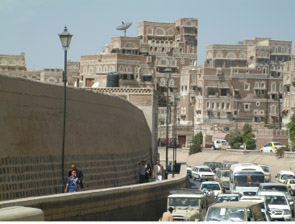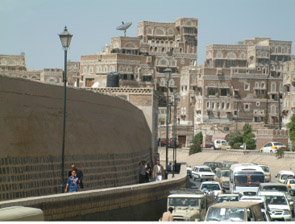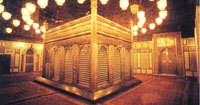
The wall of the Old City of Sana’a:salient evidence of a great civilization [Archives:2008/1147/Last Page]
April 17 2008
 |
Throughout hundreds of years, the wall surrounding the Old City of Sana'a has preserved its marvelous capacity to surprise its beholders, manifesting its presence in numerous books of great historians and the diaries of trekkers and visitors.
In fact, one would be hard-pressed to find a book about the Old City not containing information about the wall, one of the most attractive ancient sites in the capital, which is believed to be one of the world's oldest cities, as it's often said that the Old City of Sana'a was built by Noah's son, Shem.
If talk about Sana'a is always linked to its ancientness and its marvelous capacity to preserve its ancient characteristics, the wall is one of the city's most salient historical sights, and therefore, clear evidence of the ancientness, the glorious history and the uniqueness of Yemeni civilization.
Erecting walls around cities seems to be a general phenomenon in the history of ancient civilizations. Walls were built around cities, thereby functioning as defense barriers to protect cities and hamlets from conquest.
Yemen had practiced the phenomenon since pre-Islamic times, with ancient remains revealing that most of its old cities, such as Aden, Zabid, Sa'ada and Marib, were walled.
Such walls typically were erected around cities located in plains areas to protect them, unlike cities and hamlets in mountainous areas, which used the surrounding mountains to protect themselves from their enemies.
Conflicting details
A city should be able to protect itself from any attacks against it. Due to lack of political stability, Sana'a was subjected to invasion and looting by tribes in neighboring areas. For these reasons, a strong wall was built around the city and is considered one of the city's most ancient sights, despite the fact that it has been rehabilitated several times.
Historical books and narratives differ about when the Old City wall was built, but numerous references and studies depend upon the legacy of Yemen's great historian, Abu Mohammed Al-Hassan Al-Hamdani (893-947 A.D.).
In his book “Al-Iklil,” Al-Hamdani argued that Shar Autur, a Sabeen King built the wall and some of the marvelous palaces, which Imam Abu baker Al-Razi affirmed in his book, “The History of Sana'a.” According to Al-Razi, Shar Autur was a Sheban king who ruled many areas of Yemen during the final days of the second century A.D.
Other historians believe the wall's pillars belong to the Sheban era, substantiating their view on identical structures at Marib Dam and other walls of the Sheban city. On the old city's wall there are forts, towers and 128 naubas.
A nauba is a cylindrical-shaped room built on a wall and used to guard a city. Built of red brick, some naubas still remain, but due to ignorance and lack of maintenance, they've been subjected to erosion.
In his book, “Al-Masjed Al-Masbouk,” Abu Al-Hassan Bin Ali Al-Khazraji explained how Sultan Ali Bin Hatim Al-Hamdani destroyed the Sana'a route nearly 860 years ago in 570 Hijra, demolishing its trenches and removing other ancient attractions upon hearing of the arrival of Turan Shah Al-Ayoubi, an Ottomani army commander to Sana'a. Afterward, Taghkeen Al-Ayoubi, another commander rebuilt the wall in the same century.
The wall was ruined again in 1036 and a few years later, Mohammed Ali Basha, a ruler at that time, order the best builders to restore it.
Its gates
According to Ibn Al-Mujawer, there are seven gates on the Old City wall: Bab Ghamdan, Bab Damashq, Bab Al-Sabah, Bab Khandaq Al-Aala, Bab Al-Khandaq Al-Asfal, Bab Al-Nasr and Bab Shara'a.
However, in a recent narrative, Judge Mohammed Al-Qadhi said they knew of only four gates around the Old City of Sana'a: Bab Al-Yemen, Bab Shaoub, Bab Al-Sabah and Bab Al-Qasr.
Architectural beauty
The Old City's beauty stems from its abundance of high towers that bewitch trekkers. Homes in the form of towers constitute the main infrastructure of Sana'a and give the city an optical impression different from other Islamic cities.
Gazers realize that most Old City homes consist of five to eight stories, each with a particular function. For instance, the fourth floor contains the mafraj, a room for receiving guests. Well-furnished due to its distinctive location, this room also has many windows.
Additionally, the diversity of decorations on the front of these homes is unique and eye-catching.
Old City homes typically occupy a small area, with their gates leading directly to the road or lane outside. Large homes aren't easily distinguishable from small ones and tall homes prevent any beholders from viewing the basatine, or gardens.
Numerous factors are considered in designing Old City homes. Some of these factors are natural such as cold, heat and air, while others are social or human. Builders shouldn't ignore these factors because they assist in the choice of construction material in order to ensure that their inhabitants lead happy lives. For example, the sides of the structure, particularly its front and how many floors are to be built, should be decided upon before construction begins.
——
[archive-e:1147-v:18-y:2008-d:2008-04-17-p:lastpage]


